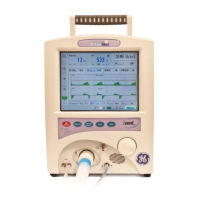5 Adaptive Bi-Level
131
INTRODUCTION
In this section the following is discussed:
The fundamentals of Adaptive Bi-Level mode
Which patients indicate for Adaptive Bi-Level mode
How to set up the ventilator for A-B
How to resolve patient-ventilator asynchrony
ABOUT ADAPTIVE BI-LEVEL
In VersaMed’s Adaptive Bi-Level mode the iVent
TM
201 can accommodate high
leak situations - for instance, when using a facemask (sometimes referred to as
non-invasive ventilation) or pressure support for high leak ET tube ventilation
(Passy Muir® and cuffless applications). It is an important component in the
arsenal of therapies that can be applied to patients presenting with respiratory
insufficiency.
Adaptive Bi-level is a support mode of ventilation with a settable minimum rate. If
the patient fails to breathe above this minimum rate the ventilator will initiate
extra breaths to maintain the minimum rate. These extra ventilator-initiated
breaths are flow terminated like the patient initiated support breaths.
GUIDE TO ADAPTIVE BI-LEVEL
Adaptive Bi Level is a support mode of ventilation, where spontaneous breathing
efforts are pressure supported at a high (inspiratory) and low (expiratory)
pressure. In the absence of spontaneous breathing efforts, the ventilator provides
mandatory breaths at a rate indicated by the “respiratory rate” setting. The
default setting should be lower than the spontaneous breathing rate to reduce
dysynchrony with patient breathing efforts.
Breaths can be terminated by a reduction in peak flow to a pre-selected
percentage. In high leak situations, cycling to exhalation by reduced flow could
be compromised and an appropriate (maximum) I-time which acts as a backup to
the flow termination mechanism should be set to prevent breath stacking.
Either Nasal CPAP masks or full facemasks can be used with Adaptive Bi-Level.
Patients who breathe with their mouths should use a full facemask or if not
available, a nasal mask with suitable chinstrap support. When using higher
inspiratory pressures, it is also recommended to use a full facemask to prevent
the escape of inflationary pressure via the oral cavity. See Table 9 at the end of
this section for recommended masks.

